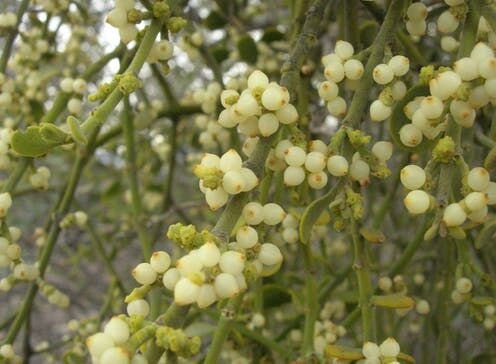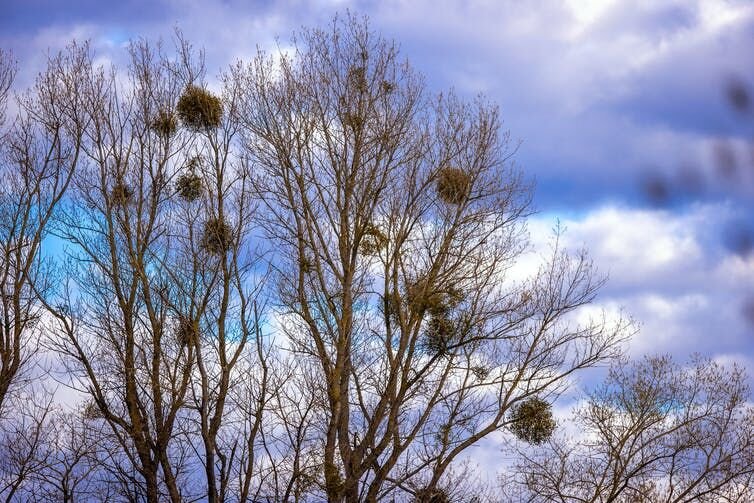
A parasitic plant with potentially poisonous berries might not sound like something that would boost your Christmas decorations to the next level. But, botanically speaking, that’s what mistletoe is.
There are some 1,300 species of this evergreen plant worldwide. They’re all parasitic or semiparasitic, meaning they can survive only on a host plant. Rather than being rooted in the ground, they live on the branches of other trees and shrubs.
Just two types are native to North America. Twelve species of the American mistletoe can be found distributed largely across the southern half of the U.S., mostly affecting deciduous trees in the East as well as some evergreens in the West. Sixteen species of the leafless dwarf mistletoe infect only trees in the pine family and are mostly found along the West Coast.
The American mistletoe, the one used at Christmas in the U.S., is in the genus Phoradendron, which means “thief of the tree” in Greek. It has green leaves and is capable of photosynthesis and so produces much of its own food. But American mistletoe also sucks water and other nutrients out of its host plant by sending rootlike structures called haustoria into the vascular tissue just under the bark of branches and twigs. These invading structures can live for many years inside a tree even if the mistletoe plant itself is removed.
Mistletoes are what botanists call dioecious, meaning these plants have separate male and female versions. The females produce the fruits, called berries, which are generally white, but can be pink or reddish depending on the species. Birds widely distribute the seeds after eating the berries. Seeds of some species can also be shot out of the fruit like a cannonball at up to 60 mph (100 kph) to a distance as far as 50 feet (15 meters). A sticky substance on the seeds helps them attach to any tree they land on until they germinate and begin to grow.

In general, mistletoe won’t kill a tree unless it is heavily infested. Even then the tree doesn’t usually die from the mistletoe; most often death is an indirect effect of attacks from diseases or insects that take advantage of the stressed tree. Mistletoe’s parasitic ways can cause significant economic damage to forests industrially harvested for lumber.
For a homeowner, though, it’s usually not necessary to control mistletoe – which is good, since getting rid of it can be difficult and takes patience and persistence. You can prune it out, being sure to get all those spreading haustoria under the host’s bark, or try chemical controls like the plant growth regulator ethephon.

Maybe you’ll want to trim a sprig to decorate with during Christmastime. One of the most common traditions associated with mistletoe, dating back at least to the 1700s, is that anyone lingering beneath it would welcome a holiday kiss. Here in my home state of Oklahoma, mistletoe is our state floral emblem, apparently because it was the only greenery available to put on graves during the particularly hard winter of 1889. In other parts of the world, mistletoe is considered to bestow life and fertility, serve as a peace offering and protect against poison.
About poison: Mistletoe has a reputation as a poisonous plant. While the European species Viscum album is reportedly toxic, American mistletoe is not deadly. Better to keep it away from little kids and pets, though, and if you are concerned, stick with artificial mistletoe for decorative purposes.

Mistletoe is an important part of the ecosystem in the places where it grows in North America. Lots of birds rely on mistletoe berries as a food source, as do elk, deer, squirrels, chipmunks and even porcupines, which will also eat the leaves when other fresh foliage is scarce. Tangled clumps of mistletoe, traditionally referred to as witches’ brooms, provide nesting sites for birds, including spotted owls and Cooper’s hawks, and other animals. Three kinds of butterflies in the U.S. are entirely dependent on mistletoes. And it’s also an important nectar and pollen plant for honey bees and other native bees.
So this parasitic plant plays a valuable role in both ecosystems and human traditions. If it grows near you, enjoy it because you probably wouldn’t be able to completely get rid of it anyway. And at Christmastime, it just may come in handy.
[Like what you’ve read? Want more? Sign up for The Conversation’s daily newsletter.]
 David Hillock does not work for, consult, own shares in or receive funding from any company or organization that would benefit from this article, and has disclosed no relevant affiliations beyond their academic appointment.
David Hillock does not work for, consult, own shares in or receive funding from any company or organization that would benefit from this article, and has disclosed no relevant affiliations beyond their academic appointment.
This article is republished from The Conversation under a Creative Commons license.
-
10 tips for a more sustainable holiday season
AlexMaster // Shutterstock
The holidays are filled with fantastic feasts, time with family and friends, and memorable moments that last a lifetime. They are also the most trash-filled months of the year. According to the Environmental Protection Agency, household waste goes up more than 25% in the time between Thanksgiving and New Year’s Day. Bins filled with shopping bags, leftover food, single-use wrapping paper, and unwanted gifts add up to 1 million tons of waste per week to U.S. landfills.
There are several steps people can take toward sustainable consumption, though: buying gifts made of environmentally friendly materials and those that will last and won’t simply end up in landfill piles, regifting, and giving second-hand or heirloom items go a long way toward reducing waste. In the hopes of helping others have a more sustainable holiday season, Almond Cow compiled a list of ideas to celebrate the winter holidays with the planet in mind.
Find out what holiday habits and traditions can be revamped in the name of having an eco-friendly holiday season. Discover which method of transportation is the best for the environment. Learn why real trees are best when it comes to celebrating a sustainable holiday, and how renting a tree could become a new environmentally forward family tradition.

AlexMaster // Shutterstock
The holidays are filled with fantastic feasts, time with family and friends, and memorable moments that last a lifetime. They are also the most trash-filled months of the year. According to the Environmental Protection Agency, household waste goes up more than 25% in the time between Thanksgiving and New Year’s Day. Bins filled with shopping bags, leftover food, single-use wrapping paper, and unwanted gifts add up to 1 million tons of waste per week to U.S. landfills.
There are several steps people can take toward sustainable consumption, though: buying gifts made of environmentally friendly materials and those that will last and won’t simply end up in landfill piles, regifting, and giving second-hand or heirloom items go a long way toward reducing waste. In the hopes of helping others have a more sustainable holiday season, Almond Cow compiled a list of ideas to celebrate the winter holidays with the planet in mind.
Find out what holiday habits and traditions can be revamped in the name of having an eco-friendly holiday season. Discover which method of transportation is the best for the environment. Learn why real trees are best when it comes to celebrating a sustainable holiday, and how renting a tree could become a new environmentally forward family tradition.

-
10 tips for a more sustainable holiday season
Elena Mitusova // Shutterstock
For the sake of sustainability, it makes sense to phase out that one-life environmentally unfriendly gift wrap. Fabric is a popular reusable substitution and offers a variety of colors and patterns, and there is no paper waste. Recyclable gift wrap, which can be reused several times, is also an option if fabric isn’t your thing. There is no need for tape to wrap up presents, either. Twine and biodegradable, compostable paper tape (made from pulp, wood fiber, or bark, and natural adhesives) are eco-friendly options. Paper tape comes in different patterns, and some rolls even feature sustainable glitter.
Elena Mitusova // Shutterstock
For the sake of sustainability, it makes sense to phase out that one-life environmentally unfriendly gift wrap. Fabric is a popular reusable substitution and offers a variety of colors and patterns, and there is no paper waste. Recyclable gift wrap, which can be reused several times, is also an option if fabric isn’t your thing. There is no need for tape to wrap up presents, either. Twine and biodegradable, compostable paper tape (made from pulp, wood fiber, or bark, and natural adhesives) are eco-friendly options. Paper tape comes in different patterns, and some rolls even feature sustainable glitter.
-
-
10 tips for a more sustainable holiday season
Dmitrijs Mihejevs // Shutterstock
When it comes to travel, carbon dioxide is highest on a plane. A train cuts the amount of CO2 in half and is much more environmentally friendly when it comes to holiday travel. According to Treehugger, the reason for this is simple: While the train emits a significant amount of carbon, it can also carry a significant amount of passengers, making per capita emissions much lower. Planes also emit tropospheric ozone and produce vapor trails, which can have a real impact on climate. A recent study, published in Environmental Science & Technology, found that both driving a car passenger-less and flying on a plane that is at 80% occupancy have a similar impact on climate. If you plan to travel by car, carpool and take as many passengers as you can during that road trip.
Dmitrijs Mihejevs // Shutterstock
When it comes to travel, carbon dioxide is highest on a plane. A train cuts the amount of CO2 in half and is much more environmentally friendly when it comes to holiday travel. According to Treehugger, the reason for this is simple: While the train emits a significant amount of carbon, it can also carry a significant amount of passengers, making per capita emissions much lower. Planes also emit tropospheric ozone and produce vapor trails, which can have a real impact on climate. A recent study, published in Environmental Science & Technology, found that both driving a car passenger-less and flying on a plane that is at 80% occupancy have a similar impact on climate. If you plan to travel by car, carpool and take as many passengers as you can during that road trip.
-
10 tips for a more sustainable holiday season
Checubus // Shutterstock
Millions of artificial trees are purchased in the U.S. each Christmas season, and according to The Nature Conservancy, 90% of these trees are manufactured overseas in China. Shipping them overseas creates an increase in carbon emissions. Not to mention that artificial trees are made of non-biodegradable plastics and often contain harmful chemicals like lead. Living Christmas trees are an eco-friendly option that, while single-use for each Christmas season, can be recycled. Real trees also smell great and help Christmas tree farms stay in business, which supports sustainable forestry. If chopping down a real tree isn’t your thing, consider renting a real Christmas tree that can be replanted at the end of the season. While real trees are a better alternative to artificial ones, it is important to note that many Christmas tree farms use a mix of pesticides and herbicides to control pests and fungi.
Checubus // Shutterstock
Millions of artificial trees are purchased in the U.S. each Christmas season, and according to The Nature Conservancy, 90% of these trees are manufactured overseas in China. Shipping them overseas creates an increase in carbon emissions. Not to mention that artificial trees are made of non-biodegradable plastics and often contain harmful chemicals like lead. Living Christmas trees are an eco-friendly option that, while single-use for each Christmas season, can be recycled. Real trees also smell great and help Christmas tree farms stay in business, which supports sustainable forestry. If chopping down a real tree isn’t your thing, consider renting a real Christmas tree that can be replanted at the end of the season. While real trees are a better alternative to artificial ones, it is important to note that many Christmas tree farms use a mix of pesticides and herbicides to control pests and fungi.
-
-
10 tips for a more sustainable holiday season
Foxys Forest Manufacture // Shutterstock
Adding plant-forward menu options to your holiday feast does not eliminate animal products, but instead focuses on making more plant-based foods, like fruit and vegetables. One 2019 study found 49.6% fewer greenhouse gas emissions were produced with a plant-based diet. Many plant-based holiday recipes are easy to find and simple to make.
Foxys Forest Manufacture // Shutterstock
Adding plant-forward menu options to your holiday feast does not eliminate animal products, but instead focuses on making more plant-based foods, like fruit and vegetables. One 2019 study found 49.6% fewer greenhouse gas emissions were produced with a plant-based diet. Many plant-based holiday recipes are easy to find and simple to make.
-
10 tips for a more sustainable holiday season
panuwat phimpha // Shutterstock
Donating to charities is a more sustainable choice than giving physical presents. Donating is also altruistic and makes people feel good about giving back. Charity donations don’t leave behind any waste, and they do not require a trip to the store using gas-guzzling cars. This sustainable gift choice can contribute even more to the planet if you give to a green organization that helps with environmental causes. These gifts can also be helpful come tax season as charitable donations are tax write-offs.
panuwat phimpha // Shutterstock
Donating to charities is a more sustainable choice than giving physical presents. Donating is also altruistic and makes people feel good about giving back. Charity donations don’t leave behind any waste, and they do not require a trip to the store using gas-guzzling cars. This sustainable gift choice can contribute even more to the planet if you give to a green organization that helps with environmental causes. These gifts can also be helpful come tax season as charitable donations are tax write-offs.
-
-
10 tips for a more sustainable holiday season
Nick Beer // Shutterstock
A greener option than regular string lights, solar-powered lights do not require the use of standard electricity. They do not produce emissions that pollute the environment such as carbon dioxide and nitrous oxide. This eco-friendly lighting choice is also safer and more aesthetically pleasing because these lights do not require power cords. Solar-powered string lights use energy from the sun to operate and a few hours of sunshine in the afternoon will power lights all night, and they are a more affordable option than traditional holiday string lights in terms of saving on your electric bill. This sustainable holiday choice is also available at major retailers and the purchase price is comparable to standard LED string lights.
Nick Beer // Shutterstock
A greener option than regular string lights, solar-powered lights do not require the use of standard electricity. They do not produce emissions that pollute the environment such as carbon dioxide and nitrous oxide. This eco-friendly lighting choice is also safer and more aesthetically pleasing because these lights do not require power cords. Solar-powered string lights use energy from the sun to operate and a few hours of sunshine in the afternoon will power lights all night, and they are a more affordable option than traditional holiday string lights in terms of saving on your electric bill. This sustainable holiday choice is also available at major retailers and the purchase price is comparable to standard LED string lights.
-
10 tips for a more sustainable holiday season
goodluz // Shutterstock
Sure, expedient shipping is amazing, and sometimes with the hustle and bustle of the holidays, it seems like a simple fix for managing time, but it comes with a steep environmental cost. While online shopping is more eco-friendly than retail shopping, when used for rush delivery, it essentially voids any environmental benefit. Rush shipments often go out without full loads, which increases harmful emissions. Ordering early allows more time for shipping. Preplanning and not waiting until the last minute when doing holiday shopping are helpful.
goodluz // Shutterstock
Sure, expedient shipping is amazing, and sometimes with the hustle and bustle of the holidays, it seems like a simple fix for managing time, but it comes with a steep environmental cost. While online shopping is more eco-friendly than retail shopping, when used for rush delivery, it essentially voids any environmental benefit. Rush shipments often go out without full loads, which increases harmful emissions. Ordering early allows more time for shipping. Preplanning and not waiting until the last minute when doing holiday shopping are helpful.
-
-
10 tips for a more sustainable holiday season
everything possible // Shutterstock
Panic buying is a big reason why people purchase too much, choosing quantity over quality, and this year it may seem especially enticing to buy fast and furious given the supply chain issues. A little pre-planning and early shopping can help combat holiday panic buying and help the environment since buying too much is generally bad for the environment. Purchasing tchotchkes that get tossed or single-use presents adds to waste that ends up in landfills. If you do wind up purchasing unwanted gifts, there are better and more sustainable options than simply tossing them. Donating, regifting with purpose, or recycling are all great options. Quality eco-friendly gift ideas include plants, an experience like rock climbing, handmade gifts, a gift certificate to a local restaurant, or even passing along a favorite item that means something to you.
everything possible // Shutterstock
Panic buying is a big reason why people purchase too much, choosing quantity over quality, and this year it may seem especially enticing to buy fast and furious given the supply chain issues. A little pre-planning and early shopping can help combat holiday panic buying and help the environment since buying too much is generally bad for the environment. Purchasing tchotchkes that get tossed or single-use presents adds to waste that ends up in landfills. If you do wind up purchasing unwanted gifts, there are better and more sustainable options than simply tossing them. Donating, regifting with purpose, or recycling are all great options. Quality eco-friendly gift ideas include plants, an experience like rock climbing, handmade gifts, a gift certificate to a local restaurant, or even passing along a favorite item that means something to you.
-
10 tips for a more sustainable holiday season
Albina Gavrilovic // Shutterstock
While often made from paper, many greeting cards cannot be recycled. The inks and dyes they use to create colors may contain volatile organic compounds (VOCs). VOCs have a significant and lasting impact on the environment and on human health. Most of the millions of greeting cards purchased each year are given out during the holidays and create a significant amount of waste. Thinking of an e-card? A single email requires a surprising amount of electricity and produces roughly 4 grams of CO2. A more sustainable option is to make greeting cards by hand using recyclable or biodegradable materials or simply go without. Digital holiday cards are another earth-friendly option.
Albina Gavrilovic // Shutterstock
While often made from paper, many greeting cards cannot be recycled. The inks and dyes they use to create colors may contain volatile organic compounds (VOCs). VOCs have a significant and lasting impact on the environment and on human health. Most of the millions of greeting cards purchased each year are given out during the holidays and create a significant amount of waste. Thinking of an e-card? A single email requires a surprising amount of electricity and produces roughly 4 grams of CO2. A more sustainable option is to make greeting cards by hand using recyclable or biodegradable materials or simply go without. Digital holiday cards are another earth-friendly option.
-
-
10 tips for a more sustainable holiday season
Spiroview Inc // Shutterstock
Just as purchasing a real tree instead of an artificial one is a more sustainable choice, so too is buying a natural wreath than a fake one. Natural wreaths not only smell better but can be recycled at the end of the season. You can also compost real wreaths after the holidays. Making a real wreath can also be a fun way to bond with family, and going on a nature hike or walk to find natural materials to create your holiday wreath is a simple way to get a bit more oxygen and sunshine.
This story originally appeared on Almond Cow and was produced and distributed in partnership with Stacker Studio.
Spiroview Inc // Shutterstock
Just as purchasing a real tree instead of an artificial one is a more sustainable choice, so too is buying a natural wreath than a fake one. Natural wreaths not only smell better but can be recycled at the end of the season. You can also compost real wreaths after the holidays. Making a real wreath can also be a fun way to bond with family, and going on a nature hike or walk to find natural materials to create your holiday wreath is a simple way to get a bit more oxygen and sunshine.
This story originally appeared on Almond Cow and was produced and distributed in partnership with Stacker Studio.
![]() David Hillock does not work for, consult, own shares in or receive funding from any company or organization that would benefit from this article, and has disclosed no relevant affiliations beyond their academic appointment.
David Hillock does not work for, consult, own shares in or receive funding from any company or organization that would benefit from this article, and has disclosed no relevant affiliations beyond their academic appointment.



